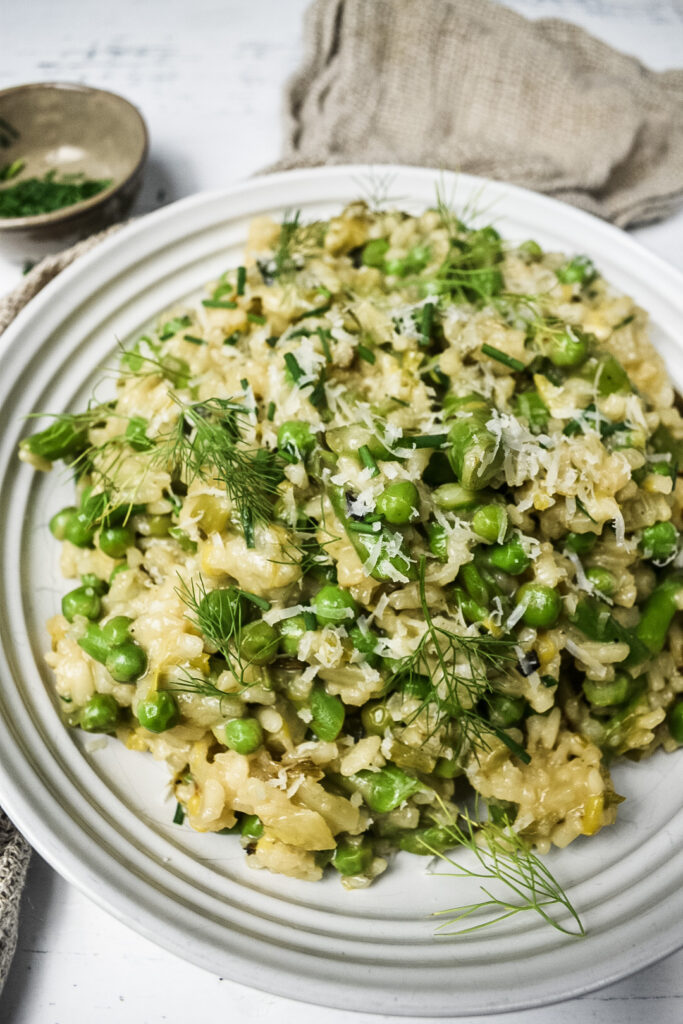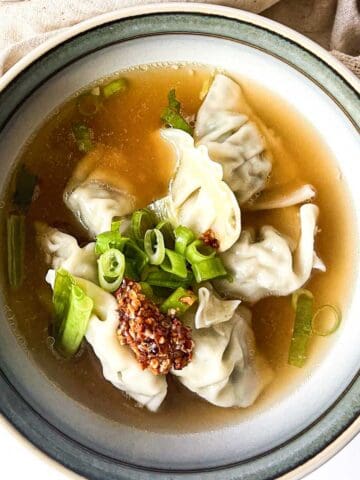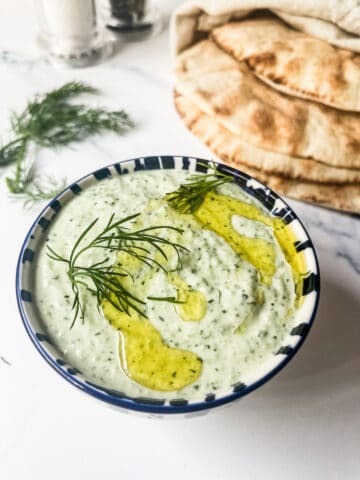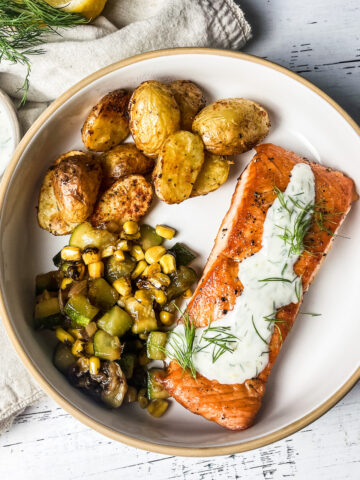Are you ready to embrace the flavors of spring? This spring green risotto recipe is here to tantalize your taste buds with its vibrant blend of asparagus, peas, fennel, creamy mascarpone, and zesty lemon zest.

Perfectly comforting yet refreshing, this dish is a celebration of the season's bounty. Whether you're a risotto enthusiast or new to this Italian classic, our step-by-step instructions will guide you in creating a luscious and satisfying meal that's sure to impress. Let's dive into the recipe and savor the taste of spring!
Looking for more risotto recipes? Try my Mushroom Risotto, Tomato Risotto, or Seafood Risotto.
Why You'll Love This Spring Green Risotto
- Fresh and Vibrant Flavors: This spring green risotto is bursting with fresh, seasonal flavors from the asparagus, peas, fennel, and lemon zest. The combination of these ingredients creates a delicious and vibrant dish that's perfect for celebrating the arrival of spring.
- Creamy and Comforting Texture: The creamy mascarpone cheese in this risotto adds a luscious and comforting texture to the dish, making it rich and indulgent. The Arborio rice also adds a perfect level of creaminess, creating a velvety and satisfying mouthfeel with each bite.
- Versatile and Customizable: This risotto recipe is highly versatile and can be easily customized to suit your preferences. You can adjust the amount of lemon zest or mascarpone cheese to your liking, and even add in other favorite spring ingredients like spinach or fresh herbs. It's a versatile dish that allows for creativity in the kitchen, making it a hit for those who love to experiment with flavors and textures.

Ingredients & Substitutions
Full list of ingredients with measurements listed below in recipe card.
- Olive oil - Adds richness and flavor to the risotto. Substitute with other types of cooking oils such as vegetable oil or melted butter.
- Unsalted butter - Provides richness and creaminess to the risotto. Substitute with salted butter, but adjust salt in the recipe accordingly.
- Leeks - Adds a mild onion-like flavor to the risotto. Substitute with finely chopped onions or shallots.
- Fennel - Adds a subtle anise-like flavor to the risotto. Substitute with celery for a similar crunchy texture.
- Arborio rice - The classic rice used for risotto, known for its creamy texture. Substitute with other short-grain rice varieties, such as Carnaroli or Vialone Nano.
- Dry white wine - Adds acidity and depth of flavor to the risotto. Substitute with chicken or vegetable broth, or omitted for a non-alcoholic version.
- Chicken stock - Provides the base for the risotto and adds flavor. Substitute with vegetable stock or broth for a vegetarian version.
- Asparagus - Adds a fresh and crisp texture to the risotto. Substitute with green beans or broccoli.
- Peas - Adds sweetness and color to the risotto. Substitute with fresh or frozen edamame or green beans.
- Lemon zest - Adds a bright and tangy flavor to the risotto. Substitute with lime zest for a different citrus twist.
- Mascarpone cheese - Adds creaminess and richness to the risotto. Substitute with cream cheese or ricotta cheese for a similar texture.
- Parmesan cheese - Adds nuttiness and saltiness to the risotto. Substitute with Pecorino Romano or Grana Padano cheese.
- Chives - Adds a mild onion-like flavor and freshness to the risotto. Substitute with finely chopped green onions or parsley for a similar effect.

Equipment Needed
- Large saucepan or Dutch oven - for cooking the risotto.
- Wooden spoon or silicone spatula - for stirring and mixing the risotto.
- Cutting board and knife - for chopping the leeks, fennel, and chives.
- Lemon zester or fine grater - for zesting the lemon.
- Measuring cups and spoons - for measuring the ingredients accurately.
- Ladle or liquid measuring cup - for adding the chicken stock and wine to the risotto.
- Cheese grater - for grating the Parmesan cheese.
- Serving dish or individual plates - for serving the finished risotto.

How to Make Spring Green Risotto
Full step-by-step instructions listed below in recipe card.
To make the spring green risotto, start by heating the olive oil and butter in a large saucepan or Dutch oven over medium heat. Add the chopped leeks and fennel, and sauté for 5 to 7 minutes until they are tender. Then, add the Arborio rice and stir for a minute to coat the rice with the vegetables, oil, and butter.



Next, add the dry white wine and simmer over low heat, stirring constantly, until most of the wine has been absorbed. Gradually add the simmering chicken stock, 2 ladles at a time, stirring almost constantly and waiting for the stock to be absorbed before adding more. This process should take about 25 to 30 minutes, and it helps to create a creamy texture in the risotto.


While the risotto is cooking, prepare the asparagus by cutting them diagonally into 1 ½-inch lengths and blanching them in boiling salted water for 4 to 5 minutes until they are al dente. Drain and cool them immediately in ice water. If using fresh peas, blanch them in boiling water for a few minutes until the starchiness is gone.
When the risotto has been cooking for 15 minutes, add the blanched asparagus, peas, lemon zest, salt, and pepper to the risotto. Continue cooking and adding stock, stirring almost constantly, until the rice is tender but still firm.



In a small bowl, whisk together the lemon juice and mascarpone cheese. When the risotto is done, turn off the heat and stir in the mascarpone mixture along with the Parmesan cheese and minced chives. Set the risotto aside, off the heat, for a few minutes to allow the flavors to meld.



To serve, sprinkle the risotto with additional salt, pepper, chives, and Parmesan cheese. You can also garnish with extra lemon zest for a burst of freshness. Enjoy this creamy, flavorful spring green risotto as a delicious and satisfying main course or side dish!
Variations
- Vegetarian/Vegan: To make this recipe vegetarian or vegan, simply substitute vegetable broth for the chicken broth, and omit the butter and Parmesan cheese. You can use vegan butter or margarine, and nutritional yeast as a substitute for the Parmesan cheese for a creamy and cheesy flavor.
- Seafood: For a seafood twist, you can add cooked shrimp, scallops, or diced cooked fish, such as salmon or cod, to the risotto during the last few minutes of cooking. This adds a burst of seafood flavor and a touch of elegance to the dish.
- Mushroom: If you love mushrooms, you can add sautéed or roasted mushrooms to the risotto for an earthy and savory flavor. You can use a variety of mushrooms such as cremini, shiitake, or porcini to add depth and richness to the dish.
- Herb-infused: Experiment with different herbs to infuse the risotto with unique flavors. Fresh herbs like basil, thyme, or parsley can be finely chopped and added to the risotto during the cooking process for a burst of freshness and aroma.
- Cheesy: If you're a cheese lover, you can add different types of cheese to the risotto to create a rich and creamy dish. Try using Gorgonzola, fontina, or goat cheese for a tangy and creamy flavor profile.
- Lemon-Free: If you prefer a milder flavor, you can omit the lemon zest and lemon juice for a more subtle taste. Instead, you can add a splash of white wine or a pinch of white wine vinegar for acidity.
- Grain Alternatives: While Arborio rice is traditionally used for risotto, you can also experiment with other grains such as pearl barley, farro, or quinoa for a different texture and taste.
- Add Greens: In addition to asparagus and peas, you can add other spring greens such as spinach, kale, or Swiss chard to the risotto for added nutrition and flavor. Simply wilt the greens in the risotto during the last few minutes of cooking.

Wine Pairing
A good wine pairing for this spring green risotto would be a crisp and refreshing white wine with good acidity to complement the vibrant flavors of the asparagus and peas. Some excellent options to consider include:
- Sauvignon Blanc: This wine has bright acidity and herbaceous notes that can enhance the freshness of the risotto. Look for a Sauvignon Blanc from regions such as New Zealand, California, or Italy for a zesty and citrusy profile.
- Pinot Grigio/Pinot Gris: Another great option is a Pinot Grigio or Pinot Gris, which typically has a light and crisp character with flavors of green apple, pear, and a touch of floral notes. Look for wines from regions like Italy, Oregon, or Alsace, France.
- Vermentino: This lesser-known white wine from Italy and Corsica can be a delightful pairing with the spring green risotto. It has bright acidity, refreshing citrus notes, and a hint of minerality that can complement the dish nicely.
- Chardonnay: If you prefer a fuller-bodied wine, a Chardonnay with moderate oak and good acidity can also work well with the risotto. Look for a unoaked or lightly oaked Chardonnay from regions like California, Australia, or Burgundy, France.
Remember, personal taste preferences may vary, so it's always a good idea to taste and experiment with different wines to find the perfect match for your palate. Enjoy sipping and savoring the flavors of spring green risotto with a complementary wine pairing!

FAQ's
Can I use vegetable stock instead of chicken stock in this recipe?
Yes, you can use vegetable stock as a substitute for chicken stock to make this risotto vegetarian or vegan-friendly.
Can I use a different type of rice instead of Arborio rice?
Arborio rice is commonly used in risotto recipes due to its creamy texture and ability to absorb liquids. However, you can use other short-grain rice varieties like Carnaroli or Vialone Nano as well.
Can I use fresh asparagus and peas instead of frozen?
Yes, you can use fresh asparagus and peas if they are in season and available. Simply blanch them in boiling water for a few minutes until they are tender before adding them to the risotto.
Can I omit the mascarpone cheese or use a different type of cheese?
While mascarpone cheese adds creaminess to the risotto, you can omit it if desired or use a different type of soft cheese like cream cheese or goat cheese as a substitute.
Can I make this risotto ahead of time and reheat it later?
Risotto is best when served immediately after cooking to maintain its creamy texture. However, if you need to make it ahead of time, you can prepare the risotto until it's almost done, then reheat it on low heat with some additional stock or water and adjust the seasoning before serving.
Can I add other vegetables or herbs to this risotto?
Absolutely! You can customize this recipe by adding other spring vegetables like artichokes, spinach, or green beans, and experimenting with different herbs like basil, mint, or parsley to suit your taste preferences.
How do I store leftovers of this risotto?
If you have leftovers, store them in an airtight container in the refrigerator for up to 2-3 days. Risotto tends to thicken when refrigerated, so you may need to add some stock or water and reheat it gently on the stove while stirring to restore its creamy consistency.
Can I freeze this risotto for later use?
Risotto is not typically recommended for freezing as it can lose its texture and become mushy upon thawing. It's best to enjoy it fresh or store leftovers in the refrigerator for short-term consumption.
Can I use a different type of wine in this recipe?
While dry white wine is commonly used in risotto recipes, you can experiment with different types of wine like vermouth, dry sherry, or even sparkling wine for a unique flavor profile.
Can I make this recipe gluten-free?
Yes, you can make this recipe gluten-free by using gluten-free Arborio rice and ensuring that all the other ingredients, including the chicken stock and any added herbs or spices, are gluten-free as well.

Tips
- Use Arborio, Carnaroli, or Vialone Nano rice: These short-grain rice varieties are ideal for risotto due to their high starch content, which creates a creamy texture.
- Heat the stock: Warm the chicken stock in a separate pot and keep it simmering while making the risotto. Using hot stock helps the rice cook evenly and results in a creamier risotto.
- Add the stock gradually: Add the hot chicken stock to the rice one ladleful at a time, stirring constantly until it's absorbed before adding more. This gradual addition helps to release the starch from the rice and creates a creamy consistency.
- Stir frequently: Stirring the risotto frequently as it cooks helps to release the starch from the rice, creating a creamy texture. Use a wooden spoon or a silicone spatula to stir gently and avoid breaking the rice grains.
- Don't overcook the vegetables: If using fresh asparagus and peas, blanch them quickly in boiling water before adding them to the risotto. This helps to maintain their vibrant green color and crisp texture.
- Add cheese at the end: Add the mascarpone cheese towards the end of cooking, after the rice is fully cooked but still slightly al dente. This adds richness and creaminess to the risotto.
- Taste and adjust seasoning: Taste the risotto frequently as it cooks and adjust the seasoning with salt, pepper, and any other herbs or spices to suit your taste preferences. Remember that the chicken stock and cheese also contribute to the overall seasoning.
- Serve immediately: Risotto is best when served immediately after cooking. It tends to thicken as it cools, so aim to serve it right away for the best texture and flavor.
- Customize with additional ingredients: Feel free to add other spring vegetables, herbs, or even protein like cooked chicken, shrimp, or mushrooms to customize the risotto according to your preference.
- Enjoy leftovers creatively: If you have leftovers, you can use them creatively by shaping them into risotto cakes, mixing them with eggs for a frittata, or turning them into arancini (risotto balls) for a delicious snack or appetizer.

Looking for more recipes?
Looking for more risotto recipes? Try my Mushroom Risotto, Tomato Risotto, or Seafood Risotto.
Did You Make this Recipe?
Please leave a comment and rating below, also let me know what you thought of this recipe. Be sure to snap a picture and tag me on Instagram @Meghanitup or share it on Pinterest so that I can follow along.
HUNGRY FOR MORE? You can also follow along on Instagram and Pinterest for more recipe updates.
Recipe Card
📋 Recipe

Spring Green Risotto
Want to Save This Recipe?
Enter your email & I'll send it to your inbox. Plus, get great new recipes from me every week!
By submitting this form, you consent to receive emails from Meghan It Up.
Ingredients
- 1 ½ tablespoons good olive oil
- 1 ½ tablespoons unsalted butter
- 3 cups chopped leeks white and light green parts (2 leeks)
- 1 cup chopped fennel
- 1 ½ cups Arborio rice
- ⅔ cup dry white wine
- 4 to 5 cups simmering chicken stock preferably homemade
- 1 pound thin asparagus
- 10 ounces frozen peas defrosted, or 1 ½ cups shelled fresh peas
- 1 tablespoon freshly grated lemon zest 2 lemons
- Kosher salt and freshly ground black pepper
- 2 tablespoons freshly squeezed lemon juice
- ⅓ cup mascarpone cheese preferably Italian
- ½ cup freshly grated Parmesan plus extra for serving
- 3 tablespoons minced fresh chives plus extra for serving
Instructions
- Heat the olive oil and butter in a medium saucepan over medium heat. Add the leeks and fennel and sauté for 5 to 7 minutes, until tender.
- Add the rice and stir for a minute to coat with the vegetables, oil, and butter. Add the white wine and simmer over low heat, stirring constantly, until most of the wine has been absorbed.
- Add the chicken stock, 2 ladles at a time, stirring almost constantly and waiting for the stock to be absorbed before adding more. This process should take 25 to 30 minutes.
- Meanwhile, cut the asparagus diagonally into 1 ½-inch lengths and discard the tough ends. Blanch in boiling salted water for 4 to 5 minutes, until al dente. Drain and cool immediately in ice water. (If using fresh peas, blanch them in boiling water for a few minutes until the starchiness is gone.)
- When the risotto has been cooking for 15 minutes, drain the asparagus and add it to the risotto with the peas, lemon zest, 2 teaspoons salt, and 1 teaspoon pepper. Continue cooking and adding stock, stirring almost constantly, until the rice is tender but still firm.
- Whisk the lemon juice and mascarpone together in a small bowl. When the risotto is done, turn off the heat and stir in the mascarpone mixture, plus the Parmesan cheese and chives. Set aside, off the heat, for a few minutes, sprinkle with salt and pepper, and serve hot with a sprinkling of chives and more Parmesan cheese.
Notes
- Use homemade chicken stock for the best flavor, if possible.
- Cut the asparagus diagonally for a more visually appealing presentation.
- Blanch the asparagus and peas until al dente to retain their vibrant green color and crisp texture.
- Stir the risotto constantly while adding the chicken stock gradually to ensure a creamy consistency.
- Taste and adjust seasoning with salt, pepper, and lemon juice to suit your preference.
- Let the risotto rest off the heat for a few minutes after adding the mascarpone, Parmesan, and chives for a final touch of creaminess.
- Serve the risotto hot, garnished with additional chives and Parmesan for extra flavor.
- Experiment with different variations, such as adding cooked diced chicken, mushrooms, or herbs for added depth of flavor.
- Pair the Spring Green Risotto with a crisp white wine or a light-bodied red wine for a complementary beverage choice.





Comments
No Comments